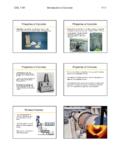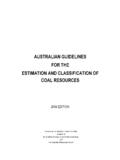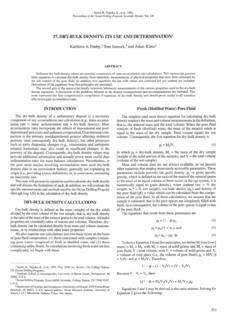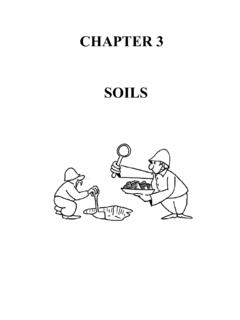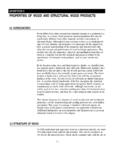Transcription of Prediction of CBR using DCP for local subgrade materials
1 Prediction OF CBR using DCP FOR local subgrade materials Gebremariam G. Feleke* and Alemgena A. Araya** *Mekelle University, EiT-M, Ethiopia, ** ALERTE ngineering Consultants, Ethiopia, - i - ACKNOWLEDGEMENT This publication of this research paperentitled, Prediction of CBR using DCP for local subgrade materials , is based on the results of a thesis submitted in partial fulfillment of the requirements for the degree of Master of ScienceinRoad and Transportation Engineering which was conducted at the Ethiopian Institute of Technology-Mekelle, Mekelle University through the sponsorshipof theEthiopian Roads authors are grateful to the Research for Community Access Partnership (ReCAP), Mr. Nkululeko Leta Regional Technical Manager,East and Southern Africa, and all organizers of this international conference for their unlimitedsupport to present the paperat the1stInternational Conference on Transportation and Road Research (ICTRR2016) which is vital to disseminate research findings and technology transfer.
2 - ii - ACRONYMS AASHTO American Association of State Highway and Transportation Officials ASTM American Society for Testing materials CBR California Bearing Ratio DCP Dynamic Cone Penetrometer DCPI Dynamic Cone Penetrometer Index DSCBR Disturbed Soaked CBR DUCBR Disturbed Unsoaked CBR FDD Field Dry Density IDOT Illinois Department of Transportation LL Liquid Limit Log Logarithm base 10 MDD Maximum Dry Density NMC Natural Moisture Content OMC Optimum Moisture Content PI Plasticity Index PL Plastic Limit R2 Coefficient of determination SCBR Soaked CBR TRL Transport Research Laboratory UCBR Unsoaked CBR UUCBR Undisturbed Unsoaked CBR - iii - Contents Acknowledgement .. i Acronyms .. ii Abstract .. iv 1. Introduction .. - 1 - 2. Literature Review .. - 2 - Description of Dynamic Cone Penetrometer .. - 2 - California Bearing Ratio (CBR) .. - 3 - Relationships between DCP Index and CBR Value.
3 - 4 - Relative Advantages and Disadvantages of DCP and CBR Tests .. - 5 - 3. Research Methodology .. - 7 - Testing Program .. - 7 - Data Source .. - 7 - Location of study .. - 7 - Excavation .. - 7 - 4. Test Results, Analysis and Discussion .. - 8 - Field Density .. - 8 - Dynamic Cone Penetrometer .. - 9 - Particle Size Distribution .. - 10 - Atterberg Limits .. - 12 - Soil Classification .. - 13 - Modified Proctor Test .. - 14 - California Bearing Ratio .. - 15 - Summary of Test Results .. - 16 - Regression Analysis and Discussion .. - 18 - 5. Conclusions and Recommendations .. - 22 - Conclusions .. - 22 - Recommendations .. - 22 - References .. - 23 - Bio data .. Error! Bookmark not defined. - iv - ABSTRACT There is lack of correlation between Dynamic Cone Penetrometer (DCP) and Soaked California Bearing Ratio (CBR) for local subgrade materials .
4 The aim of this study is to develop relationships between DCP and soaked CBR, DCP and unsoaked CBR, soaked CBR and unsoaked CBR for fine and coarse grained soils. This paper presents relationships between DCP and CBR for local subgrade materials . The relationship developed in this research considers subgrade material s behavior and largely saves time and cost of preliminary and detailed engineering works of road projects. A series of DCP tests in the field, soaked CBR at OMC, and unsoaked CBR at field conditions in the laboratory are conducted. Based on the field and laboratory test results relationships between soaked CBR and DCP, unsoaked CBR and DCP, and soaked CBR and unsoaked CBR are established for fine and coarse grained soils. The relationship developed between DCP and CBR value for fine grained soil shows better than that of for coarse grained soil.
5 Keywords: Dynamic Cone Penetrometer, Soaked CBR, Unsoaked CBR - 1 - 1. INTRODUCTION In civil engineering the investigation of subgrade materials for pavement design works become necessary to optimize structural safety and economy aspects of the road infrastructures. One of the activities during the site investigation is determination of subgrade material strength with different in-situ and laboratory tests such as the Dynamic Cone Penetrometer (DCP) test and the California Bearing Ratio (CBR) test. California Bearing Ratio (CBR) is a parameter that measures the strength of road soils and used asan integral part of pavement design. This test involves sampling, transporting, preparing, compacting, soaking, and penetrating with a plunger of CBR machine to measure the soil resistance. As it needs much time to have the end result and it cannot be easily determined in the field, civil engineers always encounter difficulties in obtaining representative CBR values for design of conducting DCP test including its analysis and interpretation takes a very short time.
6 DCP is also multi-advantageous equipment used to evaluate the in-situ strength of subgrade soil materials for road pavement works at shallow depths [1, 2, 3, 4, 5]. Therefore,predicting CBR value from DCP test and exploiting itduring performance evaluation ofpavement layers makesbetteroptionthan usingcostly and time intensive procedures. The intention of this research is to establish a relationshipbetween CBR and DCPwhich helps to predict CBR value from DCP test result that suits for the localsubgrade materials . The aim of this research is to develop relationships between DCP and laboratory determined CBR for local subgrade materials . To develop relationshipsthat predictsCBR value from DCPI for localsubgrade materials both in a soaked and in an unsoaked condition. To compare relationships of DCP and CBR developed for coarse grained soils and fine grained soils separately.
7 To enhancethe level of confidence of the DCP usage for locally used subgrade CBR determination. - 2 - 2. LITERATURE REVIEW Description of Dynamic Cone Penetrometer The Dynamic Cone Penetrometer (DCP) which is also known as the Scala penetrometer with a 9kg hammer, 508mm fall distance and 30 cone was first introduced in Australia by Scala in 1956 to assess the strength of subgrade and then during the early 1970 s DCP with a 8kg hammer, 575mm fall distance and 60 cone was standardized again by Scala in South Africa [6, 7] DCP test results consist of number of blow counts versus penetration depth. Since the recorded blow counts are cumulative values, results of DCP test in general are given as incremental values defined as follows [8], ..Equation 1 WhereDCPI = Dynamic Cone Petrometer Index in units of length divided by blow count; Dp = penetration depth; BC = Blow Counts corresponding to penetration depth Dp.
8 (a) Before hammer dropping (b) After hammer dropping Figure 2-1 Dynamic Cone Penetrometer Test [2, 8] BCDDCPIP - 3 - California Bearing Ratio (CBR) The California Bearing Ratio test (CBR), whichwas first developed during the early 1930 s, is a penetration test,wherein a standard piston, having an area of 1935mm2, is used to penetrate the soil at a standard rate of minute. The pressure at each up to recorded and its ratio to the bearing value of a standard crushed rock is termed as the CBR. The standard values of a high-quality crushed rock are as follows: Table 2-1 Penetration versus standard load values [2, 10] Penetration, mm Pressure, MPa The CBR is defined as Figure 2-2 CBR testing Machine 100 ..Equation 2 Load Unit Standard Load Test Unit (%) CBR - 4 - Relationships between DCP Index and CBR Value Salgado [8]has mentioned that the power model (or log-log equation) has been used by different authors for the relationship between the DCPI and CBR andHarison [11] hasconcluded that the log-log equation produces reliable results.
9 Farshad [4], Ferede [12], and Ehsan [13] also mentioned that most of the relationships developed between DCP and CBRare based on the best fit log-log equation having the form: log(CBR) = A + Blog(DCPI)..Equation 3 Where CBR = California Bearing Ratio in percent DCPI = DCP penetration resistance or penetration index in units of mm per blow A and B are regressionconstantsfor therelationship Table 2-2 Relationships developedbetween CBR and DCPI by different authors [2, 4, 8, 12] Correlation Equation Soil type Reference log(CBR) = (DCPI) all Harison (1989) log(CBR) = (log DCPI) all Livneh (1987) log CBR = (DCPI) or CBR = 292/ DCPI all Army Corps of Engineers (1992) log(CBR) = (DCPI) all TRL log(CBR) = (DCPI) (R2 = ) Clay unsoaked Yitagesu(2012) log(CBR) = (DCPI) cohesive TRL 1986 log(CBR) = (DCPI) all IDOT 1997 Karunaprema and Edirisinghe [14, 15] have made investigation on the different conditions of CBR as show in table2-3 and made discussions on the different models usedfor the statistical analysis of their research data and on the values of R2 which is - 5 - explained as the coefficient of determination that measures the goodness of fit.
10 It ranges from 0 to 1. If R2 is greater than , the determination is considered as acceptable. Moreover Mendenhall, Beaver and Beaver [16] strengthen that regression analyses result with a coefficient of determination R2 = , or , is substantial. The regression model is working very well. Table 2-3 Summary of statistical analysis [14] Correlation Model Equation MSE R2 DCP/ DUCBR Linear CBR= + Logarithmic CBR = (DCP)+ Exponential CBR = Power Log CBR = DCP/ UUCBR Linear CBR = + Logarithmic CBR = (DCP)+ Exponential CBR = Power Log CBR = - DCP/ DSCBR Linear CBR = Logarithmic CBR = (DCP) + Exponential CBR = Power Log CBR = Relative Advantages and Disadvantages of DCP and CBR Tests Table 2-4 Relative advantages and disadvantages of DCP and CBR tests [4, 13, 14]











